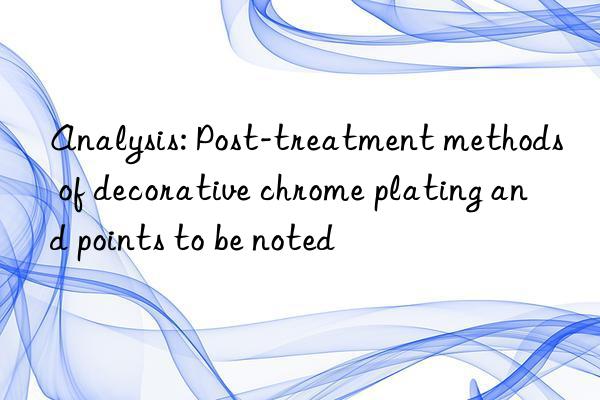
After chrome plating, the parts are rinsed with cold and hot water, and treated with 10% sodium carbonate solution to remove the remaining The chromic acid is neutralized, then rinsed, dried, and polished on the felt wheel with chromium oxide polishing paste. Dehydrogenation heating method ①The thin-walled products with high hardness are heated in an oil bath at 150~200℃ for 2~3h. Products with high hardness and large cross-section are not required. Heated at a temperature not lower than 300℃ for 3h . ②The chromium-plated products cannot be heated at a temperature above 650-700℃, because the combination of chromium and chromium will deteriorate at this time. ③Parts chrome-plated for the purpose of corrosion prevention are not suitable for heating. Removal of poor quality chrome plating ① Dissolve in 15%-20% hydrochloric acid solution at room temperature, with certain additives added to the solution. This method is applicable to steel, copper, brass, copper-plated and nickel-plated parts. ②At a current density of 10-20A/dm2 and room temperature, it is anodicly dissolved in 5%-10% caustic soda solution. This method is suitable for steel products. In order to avoid the dissolution of the main metal, care must be taken to ensure that the alkali solution does not contain chloride when applying the anode removal method. ③To remove the chromium layer and the nickel layer together, it is best to dissolve the anode in an 80% sulfuric acid solution at a current density of 3 to 5A/dm2. ④The parts with the chrome layer removed should be polished before repeated chrome plating. The method of plating after removing the decorative chromium layer Due to the narrow range of operating conditions for decorative chrome plating, and the different operating conditions of the plated parts need to be changed accordingly, a little carelessness of the plating will result in different defects, which need to be removed and then plated. However, no matter what method is used to remove the original plating layer, it cannot be directly re-plated, otherwise the chromium layer may not be deposited or the chromium layer will become blurred. For example, the chromium layer cannot be directly deposited on the nickel surface after the chromium is removed by the anode method in the lye. This is because the surface of the nickel layer is oxidized during the anodic treatment, and the chromium layer is removed in hydrochloric acid. Re-plating will cause flowers. But if you take the following measures, you can get a good solution. ①Removal method in dilute hydrochloric acid. First wipe off the oil and other dirt on the surface of the strip, then tie it with nickel-plated copper wire, remove it in 1:1 clean hydrochloric acid, and remove it from the acid after it is cleaned, and use water Rinse clean and chrome plate immediately. Note: After the chromium layer is removed and the chrome plated again, the plated parts should not be in contact with the dirt. The hydrochloric acid used must be clean, and the chromium must not be removed in the acid used to pickle the steel parts. Otherwise, there are organic and Inorganic impurities will produce a replacement layer. This replacement layer can only be removed by mechanical polishing, and the replacement layer cannot be removed where it cannot be polished. ②Anode-cathode combined removal method in lye. This method can be carried out directly in the electrochemical degreasing solution. After the chromium layer is cleaned, the polarity is exchanged, so that the plated part is at the negative electrode, electrified for 5-10 seconds, and then rinsed with flowing water, weakly corroded, etc. Can be re-chrome plated. ③The anode is in the lye, and the cathode is the combined removal method in the acid. After the chromium layer is cleaned, move the workpiece to the aluminum anodizing tank after rinsing for cathode treatment: voltage 8~10V, time 3~5s. ④Anode removal in lye, combined removal method of zinc plating and dilute hydrochloric acid zinc removal. After the chromium layer is cleaned, it is rinsed and moved to the chromium plating tank for 1min of zinc plating at the normal current density, and then removed with dilute hydrochloric acid, and then chromium plated again. The method of combined removal is to use the atomic hydrogen generated during the activation of zinc removal in reducing acid to activate the surface of nickel. Chrome plating on the activated nickel layer has a very good effect. Although this is the case, it is necessary to prevent the surface cleanliness of the stripped parts from being affected by the contamination of the stripping solution, and the tied copper wires must be plated with nickel for 1 to 2 minutes to avoid tying marks with bare copper wires. |


